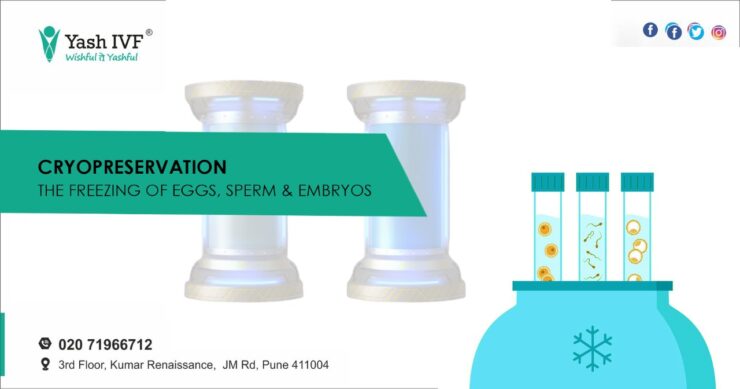This Medical advancement in fertility preservation ihas been a boon for childless couples. A process that rapidly cools & maintains gametes and embryos at cryogenic temperature without damaging the fine cell structure, it has helped many couples to overcome the challenges of infertility, ageing, and medical obstacles to fertility.
There are situations where parenthood has to be deferred to offer the best suitable environment for the family. Situations like cancer requiring radiation or chemotherapy, surgical removal of the ovaries or/and fallopian tubes are situations wherein Gamete or Embryo freezing is a veritable boon.
What exactly is Cryo-preservation?
1. Fertility Preservation essentially is the preservation of eggs, sperm and embryos
2. Preservation of such substances means stopping the multiplication and maturation of cells
3. Such biological materials are highly sensitive to environmental changes and any contamination that damages their potency
4. Such material requires a special freezing technique to prevent the growth & multiplication of cells so that they can resume multiplication after return to room temperature by another careful process of thawing
5. Any fluctuation in maintaining the preservation means changes in structures and functions that may damage functionality and prevent conception. An example is ice crystal formation within cells during freezing which damages the structure.
That is the reason, special Cryopreservation technology is employed, wherein rapid cooling is followed by suspending in liquid nitrogen at -196 deg centigrade
At cryogenic temperatures (lower than –150°C), biological materials stop their activities and metabolism and are capable of restoring growth with minimal changes after thawing to normal physiological temperatures.
Fertility preservation for women:
Breast and other cancers and ageing, personal as well as professional priorities are the most common reasons for women to consider fertility preservation. Women’s eggs also diminish in quantity and quality with age. Freezing eggs or embryos are options that can help for having healthy children in the future. Other reasons for delaying Childbearing:
Medical Conditions: autoimmune diseases, hematopoietic stem cell transplantation
Surgery of the Pelvic Area
Other Conditions: The women with poor ovarian reserve and Turner syndrome
When & What of Fertility Preservation for Men:
Sperm cryopreservation is most widely accepted in men in the following cases.
In men with poor semen quality and those who may not be available at the time of IVF, semen cryopreservation is recommended.
Surgical sperm collection from the testicle and oocyte aspiration may not coincide during IVF, therefore, surgical sperm retrieval and cryopreservation are recommended before the initiation of ovarian stimulation.
Medical Conditions: like systemic lupus erythematosus, multiple sclerosis, diabetes mellitus and cytotoxic therapy for non-cancer conditions
Genetic Condition: Klinefelter’s syndrome is a genetic condition causing azoospermia in about 90% of affected males.
Nearing andropause & yet not completed family cases, sperm cryopreservation at an earlier age is a feasible option to safeguard fertility.
Injury to the spinal cord.
Cryopreservation: technique ahead of time?
Cryopreservation is a technique that is often used to freeze and then thaw eggs, embryos or sperm for In vitro fertilization (IVF) cycles.
Such type of sperm may also be used in IUI (intrauterine insemination) treatment cycles. With the availability of frozen embryos, a woman doesn’t need to go for stimulation by fertility drugs during IVF treatment.
Does embryo cryopreservation offer any additional benefits?
Definitely yes. Multiple eggs are obtained through injections of hormones. After using the most deserving egg for fertilization, the embryos so formed can be frozen and can be used for frozentransfer cycles in the IVF process.
Embryos may be cryopreserved at any stage between day 1 and day 5, after egg retrieval. However, not all embryos are the right candidates for cryopreservation.
Experience has shown that high-quality embryos are far more able to survive and develop further than others.
Frozen embryos further add up to the success of IVF.
How invasive is the procedure, and how risky?
The process of retrieving eggs is the same as the first step of in vitro fertilization (IVF) and is performed under general anaesthesia. The woman receives a few hormone injections that produce multiple eggs. After a week or two of hormone injections, the eggs are retrieved.
Is egg freezing an experimental therapy?
It has evolved and is no longer experimental now. Many hurdles have been conquered and the preservation of such biological material has been pretty much perfected.
how are viable embryos monitored?
It is primarily the job of the Embryologist. At the time of freezing, we determine the potential viability and grading of the embryo.
We understand more about this process now and with advancements in instrumentation, it is possible to study the size, shape, and rate of multiplication at length. By examining such parameters of embryos and key factors that could affect survival during the freezing process, we can select the best embryos for freezing.
The embryology lab is the heart of this cryopreservation process. At Yash IVF our protocol is to perform ICSI / IMSI for fertilization of the egg with the sperm, grow to Day 5 (Blastocyst stage), freeze the embryos, thaw them and transfer 2 embryos at a time. We follow this protocol for almost all our patients and this is the key to our success rates being 70% plus.








Add comment